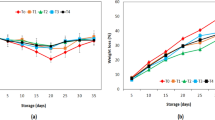Abstract
Sesame oil is an important source of nutrients. Thus, there is a need to develop new technologies, which preserve the integrity of these substances in processed oil. The aim of the study was to outline the optimal hydrothermal treatment of sesame seeds, which would enable preserving its therapeutic properties. White sesame seeds were used as raw materials. They were treated with infrared radiation (900 watts per 1 m2), followed by hydrothermal treatment. Infrared treatment decreased the seed moisture content of 10-16% by 1.5-2.0 times. A range of important compounds was preserved after treatment, such as fatty acids (ranging from 5 to 45%, depending on the type of compound). The following fatty acids were found in the oil composition: linoleic (40-43%), palmitic (7%), stearic (5%), and oleic (43-45%). In addition, vitamin E was found (130 mg per 100 g). The oil can be stored for long periods as it contains trace amounts of water and dissolved oxygen.


Similar content being viewed by others
Data Availability
Data will be available on request.
References
Asgary S, Rafieian-Kopaei M, Najafi S et al (2013) Antihyperlipidemic effects of Sesamum indicum L. in rabbits fed a high-fat diet. Sci World J 2013:365892. https://doi.org/10.1155/2013/365892
Bigdeli Shamloo MB, Nasiri M, Dabirian A et al (2015) The effects of topical sesame (Sesamum indicum) oil on pain severity and amount of received non-steroid anti-inflammatory drugs in patients with upper or lower extremities trauma. Anesth Pain Med 5(3):e25085. https://doi.org/10.5812/aapm.25085v2
El-Beltagi H, Maraei R, El-Ansary A et al (2022) Characterizing the bioactive ingredients in sesame oil affected by multiple roasting methods. Foods 11:2261. https://doi.org/10.3390/foods11152261
Huang Y, Liu C, Ge Z et al (2023) Influence of different thermal treatment methods on the processing qualities of sesame seeds and cold-pressed oil. Food Chem B 404:134683. https://doi.org/10.1016/j.foodchem.2022.134683
Ji J, Liu Y, Shi L et al (2019) Effect of roasting treatment on the chemical composition of sesame oil. LWT-Food Sci Technol 101(C):191–200. https://doi.org/10.1016/j.lwt.2018.11.008
Zheng L, Jin J, Huang J et al (2018) Effects of heat pretreatment of wet-milled corn germ on the physiochemical properties of oil. J Food Sci Technol 55(8):3154–3162. https://doi.org/10.1007/s13197-018-3243-6
Tenyang N, Ponka R, Tienchen B et al (2017) Effects of boiling and roasting on proximate composition, lipid oxidation, fatty acid profile and mineral content of two sesame varieties commercialized and consumed in far-north region of Cameroon. Food Chem 221:1308–1316. https://doi.org/10.1016/j.foodchem.2016.11.025
Mohamed Ahmed I, Musa Ozcan M, Uslu N et al (2020) Effect of microwave roasting on color, total phenol, antioxidant activity, fatty acid composition, tocopherol, and chemical composition of sesame seed and oils obtained from different countries. J Food Process Preserv 44(10):e14807. https://doi.org/10.1111/jfpp.14807
Cong Y, Zheng M, Huang F et al (2020) Sinapic acid derivatives in microwave-treated rapeseeds and minor components in oils. J Food Compos Anal 87:103394. https://doi.org/10.1016/j.jfca.2019.103394
Hu H, Liu H, Shi A et al (2018) The effect of microwave treatment on micronutrient contents, oxidative stability and flavor quality of peanut oil. Molucules 24(1):62. https://doi.org/10.3390/molecules24010062
Wang W, Yang B, Li W et al (2021) Effects of steam explosion treatment on the bioactive components and characteristics of rapeseed and rapeseed products. LWT-Food Sci Technol 143:111172. https://doi.org/10.1016/j.lwt.2021.111172
Yu G, Guo T, Huang Q et al (2020) Preparation of high-quality concentrated fragrance flaxseed oil by stream explosion treatment technology. Food Sci Nutr 8(4):2112–2123. https://doi.org/10.1002/fsn3.1505
Yoon J, Sim S, Aye A et al (2018) Kinetics of the hydrolysis of xylan based on ether bond cleavage in subcritical water. J Supercrit Fluids 135:145–151. https://doi.org/10.1016/j.supflu.2018.01.013
Mustafa A, Turner C (2011) Pressurized liquid extraction as a green approach in food and herbal plants extraction. Anal Chim Acta 703:8–18. https://doi.org/10.1016/j.aca.2011.07.018
Pereira R, Garcia V, Nava Rodrigues M et al (2016) Extraction of lignans from Phyllanthus amarus Schum. & Thonn using pressurized liquids and low-pressure methods. Sep Purif Technol 158:204–211. https://doi.org/10.1016/j.seppur.2015.12.007
Paula A, Fonseca D, Pasquel-reategui J et al (2015) Pressurized liquid extraction of bioactive compounds from blackberry (Rubus fruticosus L.) residues: a comparison with conventional methods. Food Res Int 77:675–683. https://doi.org/10.1016/j.foodres.2014.12.042
IUPAC (1987) Standard Methods for the Analysis of Oils, Fats and Derivatives: International Union of Pure and Applied Chemistry (IUPAC) Method 2.301, Report of IUPAC Working Group WG 2/87; Blackwell Scientific Publications, Palo Alto
Sadeghi N, Oveise M, Hajimahmoodi M et al (2009) The contents of sesamol in Iranian sesame seeds. Iran J Pharm Res 8(2):101–105
Mazaheri Y, Torbati M, Azadmard-Damirchi S et al (2019) Effect of roasting and microwave pre-treatments of Nigella sativa L. seeds on lipase activity and the quality of the oil. Food Chem 274:480–486. https://doi.org/10.1016/j.foodchem.2018.09.001
Bakhshandeh E, Jamali M, Afshoon E et al (2017) Using hydrothermal time concept to describe sesame (Sesamum indicum L.) seed germination response to temperature and water potential. Acta Physiol Plant 39:250. https://doi.org/10.1007/s11738-017-2549-8
Author information
Authors and Affiliations
Contributions
All authors contributed to the study conception and design. Material preparation, data collection and analysis were performed by AM, MS, AK. The first draft of the manuscript was written by AM. All authors read and approved the final manuscript.
Corresponding author
Ethics declarations
Ethics Approval
Not applicable.
Consent to Participate
Not applicable.
Consent for Publication
Not applicable.
Conflict of Interest
The authors declare that they have no conflict of interest.
Additional information
Publisher’s Note
Springer Nature remains neutral with regard to jurisdictional claims in published maps and institutional affiliations.
Rights and permissions
Springer Nature or its licensor (e.g. a society or other partner) holds exclusive rights to this article under a publishing agreement with the author(s) or other rightsholder(s); author self-archiving of the accepted manuscript version of this article is solely governed by the terms of such publishing agreement and applicable law.
About this article
Cite this article
Mukhametov, A., Kazak, A. & Serikkyzy, M. Optimal Hydrothermal Treatment of Sesame Seeds to Retain Most of the Nutrients. Plant Foods Hum Nutr 78, 207–212 (2023). https://doi.org/10.1007/s11130-022-01042-6
Accepted:
Published:
Issue Date:
DOI: https://doi.org/10.1007/s11130-022-01042-6




